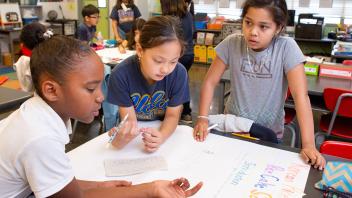Definition
Let’s start with a clear understanding of what “information literacy” means. Most definitions center on the basic communication competencies of accessing, analyzing, evaluating and communicating information.
Information literacy involves these steps:
- Planning research or posing a question — for example, “Is global warming real?”
- Organizing a way to search for the answer — divide students into groups and use a research model like the Super3™ or the Big6™ .
- Finding resources — such as databases, documentary films, Web sites (like the National Oceanic and Atmospheric Administration), print sources, and local experts.
- Evaluating the resources and thinking critically about them — Who made the message and why? What is left out of the message? How might others view the message differently?
- Expressing the information learned in meaningful ways — for example, student-produced podcasts, e-zines, and wikis.
Process
Within those simple steps are many opportunities for students to develop discrete skills like learning to synthesize and evaluate complex thoughts and ideas. Many skills are required for progress. Teacher-librarians can help by:
- Using an information gathering model. Use The Big6™ or the Super3™ as a tried-and-true method to teach students to become information users extraordinaire.
- Teaching discrete skills in real-world settings at the moments when students need to know them — like when the air conditioner breaks and it is 105 degrees!
- Providing rich opportunities and motivating materials for gathering information, such as viewing actual data online at the NOAA website .
- Providing a variety of ways for students to repackage information — like producing podcasts for the school library Web page.
Where to start
Ask students to pose simple questions about topics that interest them. Once they have their questions, help them make a plan for gathering information about the topics. Lead students to the resources and assign meaningful, technology-rich methods for them to evaluate and repackage the information they learn.
The following professional resources can help you get started:
- Get Them Thinking! Use Media Literacy to Prepare Students for State Assessments by Summers helps you teach literacy skills as you prepare students for state assessments.
- Information Literacy: Search Strategies, Tools & Resources for High School Students by Ercegovac helps teach formal research skills.
- InfoQuest: A New Twist on Information Literacy by Milam helps teacher-librarians guide students on their information quests.
- Media Literacy: Activities for Understanding the Scripted World by Endich helps you help students become media literate.
- Redefining Literacy for the 21st Century by Warlick shows you the rationale for developing information literate students and using technology.
- The Super3™ : Information Skills for Young Learners by Eisenberg & Robinson helps the very youngest learners get started researching.
Today’s students must develop information and media literacy skills in order to function in society. As teacher-librarians, we have a responsibility to use our resources to collaborate with classroom teachers to make sure that our students become both information literate and media literate. Let’s take the challenge!
Capstone Press, Initials. (2007, October). Teaching information literacy skills. Retrieved from http://www.capstonepub.com/content/TEACHER_ARTICLES.
